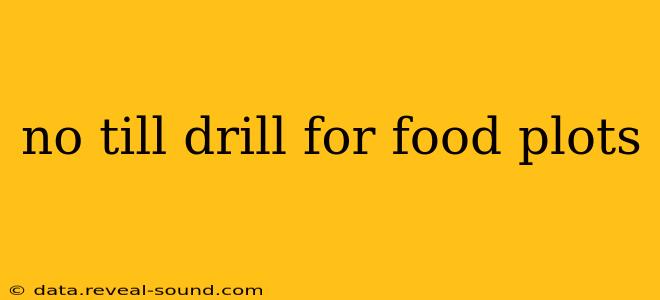Planting food plots is a crucial aspect of wildlife management and hunting success. Traditionally, this involved extensive soil preparation, including plowing and disking. However, the practice of no-till planting, using specialized no-till drills, is gaining popularity for its environmental benefits and improved efficiency. This guide explores the advantages of no-till drills for food plots and helps you choose the right one for your needs.
What is a No-Till Drill?
A no-till drill is a specialized planting machine designed to sow seeds directly into undisturbed soil. Unlike conventional methods that require plowing or disking, a no-till drill utilizes coulters or openers to create narrow slits in the soil, placing seeds precisely and covering them effectively. This minimizes soil disturbance, preserving soil structure, organic matter, and beneficial microorganisms.
Advantages of Using a No-Till Drill for Food Plots
The benefits of using a no-till drill for establishing food plots are significant:
- Reduced Soil Erosion: By avoiding tillage, no-till drilling significantly reduces soil erosion, especially on slopes or in areas with high winds. This protects valuable topsoil and prevents nutrient loss.
- Improved Soil Health: No-till practices promote healthy soil structure, increasing water infiltration and retention. This leads to better nutrient cycling and a more productive growing environment for your food plot plants.
- Weed Control: While not a complete solution, no-till drilling can help suppress weeds by leaving existing vegetation in place, reducing the weed seedbed. This can be further improved with pre-emergent herbicides.
- Time and Cost Savings: Eliminating the need for plowing and disking saves valuable time and fuel costs associated with traditional tillage methods.
- Enhanced Water Conservation: Better soil structure resulting from no-till practices improves water infiltration and retention, reducing the need for supplemental irrigation, particularly beneficial in drier climates.
- Minimized Soil Compaction: The reduced soil disturbance minimizes compaction, leading to healthier root systems and improved plant growth.
Types of No-Till Drills for Food Plots
Several types of no-till drills are available, each with its own features and advantages:
- Small No-Till Drills: Ideal for smaller food plots or individuals, these are often manually operated or have small, single-row designs. They are affordable but might be less efficient for large areas.
- Larger No-Till Drills: For larger food plots, larger, often tow-behind or three-point hitch drills are more efficient. These drills typically have wider planting widths and greater seed capacity.
- Broadcast No-Till Seeders: These machines distribute seeds over a wider area, making them suitable for establishing diverse seed mixes or cover crops. They usually require a separate operation to incorporate the seeds into the soil.
Choosing the Right No-Till Drill
Selecting the right no-till drill depends on several factors:
- Size of Food Plot: The size of your food plot will dictate the size and capacity of the drill you need.
- Type of Terrain: The terrain's slope and consistency influence the type of drill best suited for your needs. Steeper slopes might require drills with specific features to prevent seed slippage.
- Budget: No-till drills range in price from relatively inexpensive manual models to more sophisticated and costly larger units.
- Seed Type: Some drills are better suited to certain seed types and sizes.
How to Use a No-Till Drill
The process of using a no-till drill generally involves:
- Site Preparation: Clearing the area of large debris and rocks is essential for smooth operation.
- Calibration: Calibrating the drill to the correct seed rate is crucial for optimal results.
- Planting: Carefully guide the drill across the food plot, ensuring even seed distribution.
- Packing (Optional): A light packing after planting can improve seed-to-soil contact, especially in drier conditions.
What are the Different Types of Seeds Used in No-Till Food Plots?
Many seeds thrive in no-till environments. Popular choices include clovers (white clover, crimson clover), brassicas (rape, turnips), and various grains (oats, rye). The best selection depends on your region, soil conditions, and the wildlife you aim to attract.
How Deep Should I Plant Seeds in a No-Till Food Plot?
Planting depth varies depending on the seed type. Refer to the seed packaging for specific recommendations. Generally, smaller seeds require shallower planting than larger ones.
Can I Use a No-Till Drill on Rocky or Hilly Terrain?
While some no-till drills are better suited to challenging terrain than others, modifications like using smaller coulters or adjusting planting depth may be needed. Always prioritize safety and adjust your approach to match the conditions.
What are the Maintenance Requirements for a No-Till Drill?
Regular maintenance, including cleaning, lubricating moving parts, and checking for wear and tear, is vital to extending the life of your no-till drill and ensuring its continued functionality.
By understanding the advantages, types, and applications of no-till drills, you can make an informed decision and successfully establish thriving food plots, benefiting both wildlife and your hunting endeavors. Remember to consult with local experts or agricultural specialists for tailored advice based on your specific needs and geographical location.
